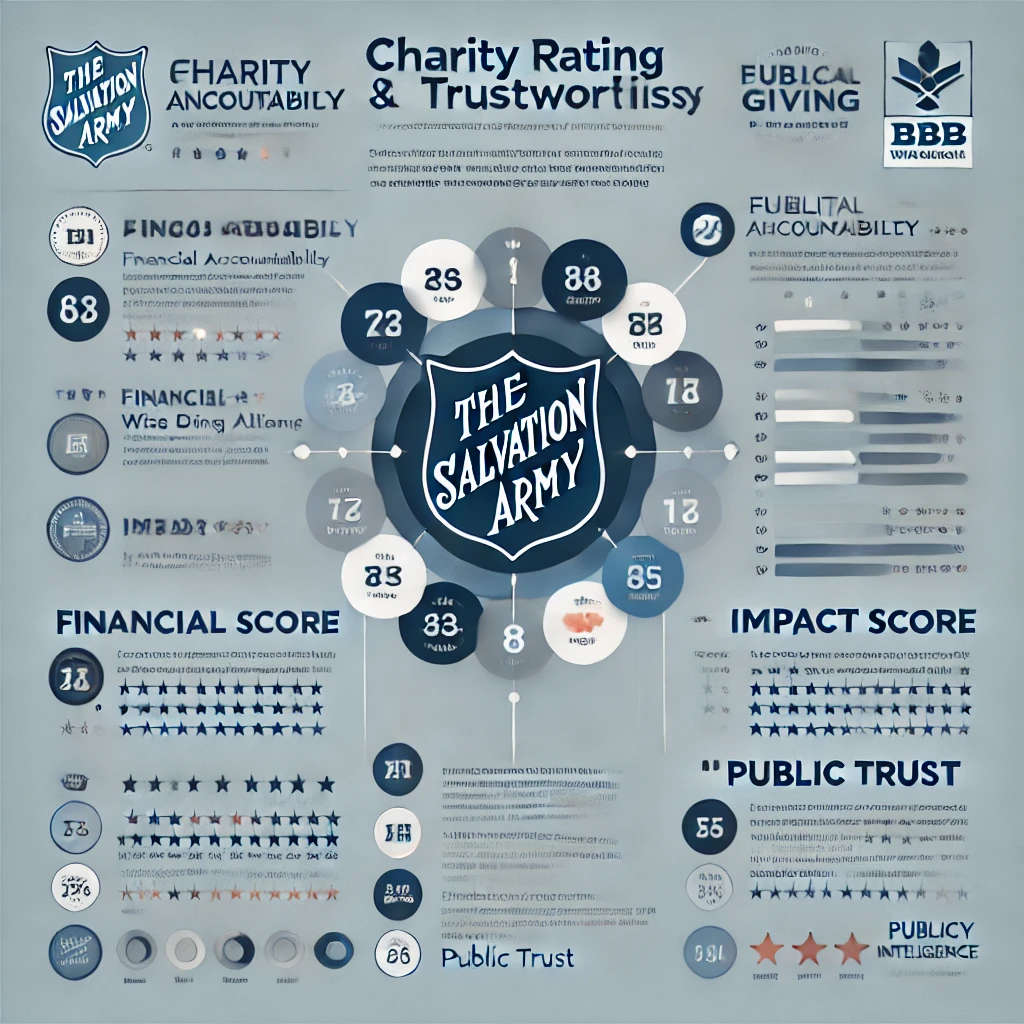NEWS
Charity Rating for Salvation Army: Evaluating Its Impact and Trustworthiness

When it comes to donating money or volunteering for a cause, people often wonder if their contributions are being used effectively. The Salvation Army, one of the largest and most recognized charities worldwide, has received both praise and scrutiny regarding its operations. Understanding the charity rating for Salvation Army helps donors and supporters determine whether this organization aligns with their values and expectations for financial responsibility and impact.
In this article, we will delve deep into the financial transparency, governance, and effectiveness of the Salvation Army, evaluating its charity ratings and how it measures up against other humanitarian organizations.
Salvation Army: A Historical Overview
The Salvation Army was founded in 1865 by William and Catherine Booth in London. Initially focused on preaching the gospel and providing aid to the poor, the organization quickly expanded its services worldwide. Today, it operates in over 130 countries, offering assistance to the homeless, disaster victims, and struggling families through various programs.
Its motto, “Doing the Most Good,” reflects its commitment to helping those in need. However, with its widespread reach, questions often arise about its financial efficiency, transparency, and accountability.
How Are Charities Rated?
Before assessing the charity rating for Salvation Army, it’s essential to understand the key factors that determine an organization’s credibility and efficiency.
1. Financial Efficiency
Charities are expected to allocate the majority of their funds toward program expenses rather than administrative costs. A well-rated charity typically spends at least 75% of its funds on direct services.
2. Transparency and Governance
Trustworthy organizations disclose their financial statements, executive compensations, and operational structures. High-rated charities provide annual reports, IRS Form 990, and independent audits to demonstrate accountability.
3. Program Impact
A crucial aspect of rating a charity is evaluating the effectiveness of its programs. Independent evaluators look at measurable outcomes, such as how many people are served and the long-term impact of their aid.
4. Ethical Practices
Charity watchdogs assess an organization’s ethical standing, including how it treats employees, whether it upholds diversity, and if it engages in controversial practices.
Charity Rating for Salvation Army: A Deep Dive
The Salvation Army is evaluated by several third-party organizations that specialize in rating non-profits. Here’s how it performs:
1. Charity Navigator Rating
Charity Navigator, one of the most well-respected charity evaluators, rates organizations based on financial efficiency, accountability, and transparency. The Salvation Army, being a church-affiliated organization, is exempt from filing IRS Form 990, making it difficult to assess all financial details. However, based on available data, local branches of the Salvation Army generally score between 80 and 100 out of 100 in financial health and transparency.
2. BBB Wise Giving Alliance
The Better Business Bureau (BBB) Wise Giving Alliance evaluates non-profits based on governance, financials, and impact. The Salvation Army meets the 20 standards for charity accountability, indicating strong ethical practices.
3. GuideStar
GuideStar provides detailed reports on charities, highlighting their financial efficiency and transparency. The Salvation Army earns a Gold Seal of Transparency, showing it shares sufficient data about its financials and programs.
4. CharityWatch
CharityWatch assigns letter grades to charities based on their spending and efficiency. Since the Salvation Army does not file IRS Form 990, it is not graded as easily as other non-profits. However, independent financial reports indicate that most of its branches spend around 82-85% of their funds on programs, which is a strong performance.
How Does Salvation Army Use Donations?
A breakdown of the Salvation Army’s expenditures provides insight into how effectively it uses donations:
| Category | Percentage of Funds Used |
|---|---|
| Program Services | 82-85% |
| Administrative Costs | 7-10% |
| Fundraising Costs | 5-8% |
This data suggests that the Salvation Army prioritizes direct services over administrative overhead, a positive sign for donors looking for impactful charities.
Comparison: Salvation Army vs. Other Charities
How does the Salvation Army compare to other well-known charities?
| Charity | Program Expenses (%) | Overall Rating (Out of 100) |
|---|---|---|
| Salvation Army | 82-85% | 80-100 |
| American Red Cross | 90% | 89 |
| United Way | 86% | 85 |
| Feeding America | 97% | 99 |
While organizations like Feeding America allocate more funds to direct programs, the Salvation Army still maintains a strong balance between impact and administration.
Common Criticisms and Controversies
Despite its positive ratings, the Salvation Army has faced criticism, including:
- Lack of IRS Form 990 Filing: Some watchdog organizations find it challenging to fully assess its finances due to its religious exemption.
- Past Controversies on LGBTQ+ Issues: The organization has been criticized for past policies that were viewed as exclusionary, though it has since worked to improve inclusivity.
- Use of Rehabilitation Labor: Some reports suggest that work-therapy programs for rehabilitation participants may not always provide fair wages.
However, the Salvation Army has taken steps to address these concerns, including policy changes and increased transparency.
Also read: Charity Navigator St. Jude: Evaluating Impact & Trust
Should You Donate to the Salvation Army?
Given the charity rating for Salvation Army, is it a good choice for donors?
Pros:
High financial efficiency (82-85% spent on programs)
Strong transparency ratings from BBB and GuideStar
Extensive global reach and community impact
Cons:
Limited financial disclosure due to IRS exemptions
Some ethical controversies in the past
For donors seeking a faith-based charity with a wide impact, the Salvation Army is a strong option. However, those who prioritize full financial transparency may prefer organizations with a more detailed public record.
Conclusion
The Salvation Army remains one of the most well-known and impactful charities worldwide. While it has some financial transparency limitations, it maintains strong ratings from charity evaluators, spends a high percentage of funds on direct programs, and continues to evolve in response to past criticisms.
For those looking to donate to a faith-based charity that provides widespread humanitarian assistance, the Salvation Army is a reputable choice. However, donors seeking full disclosure may consider alternatives with higher financial transparency ratings.
FAQs
What is the overall charity rating for Salvation Army?
It varies by location, but most branches score 80-100 out of 100 for financial transparency and effectiveness.
How much of my donation goes directly to programs?
Approximately 82-85% of donations are used for direct services.
Is the Salvation Army a religious organization?
Yes, it is a Christian charity, but it serves individuals of all backgrounds regardless of faith.
Has the Salvation Army improved its inclusivity?
Yes, the organization has updated policies to be more inclusive, particularly regarding LGBTQ+ communities.
Can I verify Salvation Army’s financial records?
Although it does not file IRS Form 990, local branches provide independent financial audits on request.
How does the Salvation Army compare to Red Cross?
The Red Cross spends 90% of funds on programs, slightly higher than the Salvation Army’s 82-85%, but both are highly rated.
Where can I donate to the Salvation Army?
You can donate online through its official website or visit local branches to contribute in person.
-

 HUMAN RIGHTS5 months ago
HUMAN RIGHTS5 months agoMercy Ships Scandal: Unraveling the Truth Behind the Allegations
-

 SOCIAL AWARENESS5 months ago
SOCIAL AWARENESS5 months agoIs Helping Hands Legit? Unveiling the Truth Behind This Organization
-

 HUMAN RIGHTS6 months ago
HUMAN RIGHTS6 months agoHuman Rights Issues: Challenges and Progress in a Globalized World
-

 SOCIAL AWARENESS5 months ago
SOCIAL AWARENESS5 months agoNational Charity League: A Legacy of Leadership and Service
